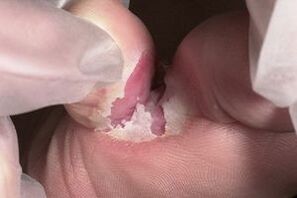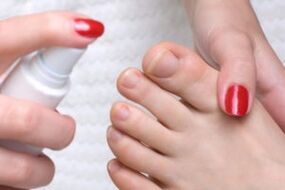Foot fungus is a skin disease that manifests itself with active reproduction in the epidermis of certain types of fungi. Today, both elderly people with weakened immune systems and children are susceptible to this disease. The signs of a fungus on the legs depend on the type of pathogen of the infectious process and the volume of the affected foot and nail, and at different stages they have certain differences, which indicate the progression of the infection. You should know how to recognize a fungus on your feet, which will allow you to start treatment in a timely manner and stop its development.

disease symptoms
The main site for the development of fungus on the legs usually becomes the area between the toes. This pathology is accompanied by the appearance of symptoms such as burning, intense itching and redness of the epidermis. In addition, a person may notice cracked and scaly skin as well as blistering on the legs and increased dryness of the dermis.
The same symptoms of a fungus on the legs can occur on the sole and are accompanied by excessive keratinization of the skin. The insidiousness of such a disease lies in the fact that, during its course, the formation of a fungus that is difficult to treat on the legs is possible, and the wounds themselves are in a state of superinfection.
How to recognize the fungus on the legs and what symptoms can signal the beginning of the development of the disease? The first signs of the disease are the appearance of small scales, that is, various types of desquamation, ranging from small pityriasis to large lamellae. There are different types of fungi that provoke the development of the disease, but they are all characterized by the same signs:

- At the initial stage of its development, the pathology proceeds without the appearance of pronounced symptoms. Firstly, the interdigital creases are affected and most often between the third and fourth fingers.
- As the fungal disease progresses, the sides of the feet are affected, gradually spreading to the ankle.
- With a fungal infection of the feet, the skin noticeably thickens, cracks and starts to glow.
- The skin becomes very dry and starts to itch a lot. In addition, the epidermis becomes very red and its affected areas become inflamed.
- Patients begin to complain of pain and burning in their feet.
- With the transition of the disease to a neglected form, blisters begin to appear on the skin. When they are opened, the affected areas of skin become very moist and tender.
There are several forms of foot fungus, and each of them is accompanied by the development of certain symptoms.
forms of pathology
Experts identify the following types of fungi that can affect the skin of the legs:
- interdigital;
- hyperkeratotic (moccasin);
- dyshidrotic.
The most common form of interdigital fungus on the feet is interdigital, characterized by the appearance of certain signs:
- most often, the area of the fourth and fifth toes becomes the location of this form of fungus.
- as the disease progresses, the skin takes on a characteristic scaly appearance and can severely crack;
- between 3, 4 and 5 a weeping slit or funnel forms, which is surrounded by white or green scales of dry skin.

Interdigital fungal skin lesions can be dry or moist. In case a wet interdigital fungus is detected, the skin appears swollen. With a dry lesion of the epidermis, its peeling and scaling is noted.
The first sign of a moccasin-like foot fungus is pain, the manifestation of which is observed in the foot. As the pathology progresses, a gradual thickening of the skin on the sole is observed, which causes the formation of cracks.
This form of fungal disease of the legs is considered the most difficult and overlooked, but it is easy to recognize. A fungal disease can manifest itself in the defeat of the nail plates, in which case they acquire a characteristic thickening, are prone to crumbling and may even fall out completely.
The vesicular form of the fungus is characterized by the formation of blisters, inside which there is a clear liquid. Gradually, these blisters mature, become cloudy and open, which causes erosions of various sizes to form. The main location of the blisters becomes the area closest to the toes on the sole, but it is possible for them to break out all over the moccasin.
The vesicular form of a fungal disease is considered to be quite rare, but much easier to treat. This is due to the fact that the vesicles become the location of the pathogen, that is, it does not penetrate into the deeper layers of the skin. When a viral or fungal infection is associated with a vesicular fungal disease, severe skin lesions are observed and treatment becomes difficult.
Specialists distinguish an erased form of the fungus on the legs, in which all symptoms are blurred. Diagnosing such a pathology is quite problematic, as the affected skin looks like a simple messy legs. In a patient with such a fungus on the feet, the symptoms are yellowing of the nails and peeling of the feet, but they are so mild that the patient does not pay attention to them.
The faded form of the fungus proceeds in waves, that is, in the hot season it becomes worse, and in winter it almost completely disappears. With any weakening of the immune system, a sharp exacerbation of the disease is observed, which creates difficulties in the treatment of foot fungus.
How to recognize onychomycosis?
The signs of nail fungus can vary significantly at different stages, signaling the progression of the infection. How does toenail fungus start and what signs should I look out for?

- In the first stage, there are no characteristic symptoms of the lesion and almost imperceptible streaks and spots appear on the nail. In the event that you ignore the first signs of the disease and start the fungus, it is possible for pus to accumulate in the area of the nail plates. The result of such a pathological process is gangrene or amputation of the lower extremities.
- With the second degree of the fungal disease, the natural shine of the nails disappears. Gradually, the nail changes color and white and brown stripes form on it. Deformation of the upper part of the nail and its lateral sections is possible. The advanced stage of bacterial nail damage is characterized by increased brittleness, delamination and inflammation of the cuticle. The pathology continues its progression and spreads to other nails and feet.
- In the third stage of onychomycosis, the nail turns dirty yellow or brown. In addition, it becomes very loose, thickens and lies behind the nail bed. Often, when wearing shoes, intense pain begins and the itching of the skin becomes simply unbearable.
There are several types of toenail fungal infections, each of which causes certain symptoms to appear.
- Hypertrophic onychomycosis is accompanied by a thickening of the nail and its coloring in yellow. The nail crumbles well and a thick epidermis is visible under it.
- Atrophic onychomycosis causes nail thinning and destruction, and keratinized skin is visible under it.
- Onychomycosis, when affected by moldy fungi, often develops not as an independent disease, but against the background of other pathologies.
The nail may be stained yellow, brown, green or black. Often, a complication develops in the form of inflammation of the nail bed with the release of pus.
pathology prevention

With the normal functioning of the immune system, nail fungus is unlikely to begin its development after infection as the body can handle it on its own. In case a fungal infection still affects the feet and nails, it is necessary to undergo an effective treatment. The sooner the fight against such a pathology begins, the greater the patient's chances of a full recovery.
The fight against foot fungus is considered a rather laborious process, so it is easier to prevent the development of the disease. For this, the following preventive measures must be observed:
- keep your feet dry;
- do not wear other people's shoes;
- choose socks made of cotton fabric;
- Do not run barefoot on the beach.
When the first signs of leg fungus appear, you should contact a specialist. It is important to identify the pathology early in its development and prevent progression, which will help to avoid many complications. To understand how to determine leg fungus, you need to consult a dermatologist.

























